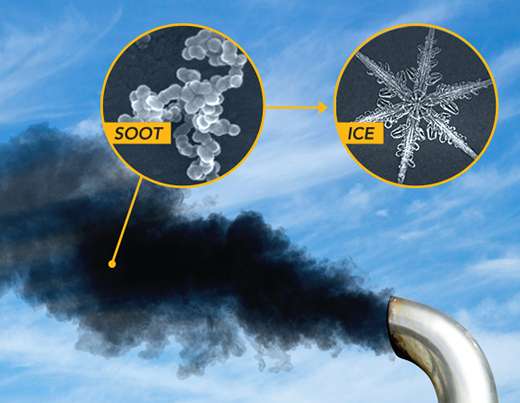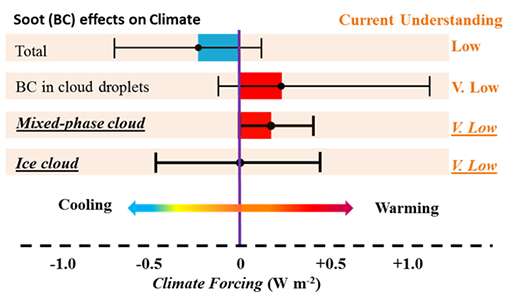Researchers used diesel pollution to understand how soot forms ice in cirrus clouds

High in the atmosphere, ice crystals are born in thin, wispy cirrus. Most of this ice birthing, what researchers call ice nucleation, is initiated on particles of soot, dust, compounds, or other droplets. Researchers at Pacific Northwest National Laboratory, Michigan Technological University, and Los Alamos National Laboratory studied a variety of soot particles they produced from a diesel generator. They emulated soot-ice nucleation in super-cold temperatures found in cirrus, up to -50° C (-122° F). The research showed that all the particles were similarly efficient at nucleating ice, but that altering the properties of soot changes the ice crystal concentration observed in clouds.
"In nature, high in the troposphere, soot particles are looking for a freezing partner," said Dr. Gourihar Kulkarni, the paper's lead author and a PNNL atmospheric scientist. "At the same time, super-cooled atmospheric water vapor needs particles to make the match," he added. "We found that soot particles can play hard to get."
Composed of ice crystals, cirrus clouds are important to the Earth's climate because they affect how sunlight (radiative) energy is filtered to the Earth's surface or blocked and reflected back into space. They have a large effect on how hot or cool the Earth may get. Throughout nature, from tiny microbes to vast air masses, cirrus ice formation takes place largely because of foreign particles. High in the atmosphere, ice may form on soot particles from various burning sources, such as smoke, dust, diesel exhaust, volcanic ash, and industrial or aircraft emissions. Soot particles, insoluble and persistent, can be pushed into the upper troposphere by tall, churning storm systems. In turn, these high-flying particulates are changed by complex interactions in the atmosphere, which in turn may change their characteristics.

Scientists have a very limited understanding of how soot particles affect the complex ice-containing clouds of the Earth's system. The findings may bring a better understanding of how cirrus and other clouds influence the Earth's radiative energy budget.
The research team produced fresh diesel soot particles using a commercial generator. The team alternately diluted the soot, cooled it, size-selected it, then physically and chemically aged it in PNNL's environmental chamber to simulate the changes that might happen in the atmosphere. Some soot particles were left bare-freshly formed and still dominated by elemental carbon. Other particles were coated with a secondary organic aerosol then grown larger and spherical. Still others were coated with a secondary organic aerosol then thermally stripped of the coating. The stripping process compacted the soot and restored its rough fractal surface. (To help in ice formation, a particle's shape, size, affinity to water, and surface roughness all matter.
To determine the ice nucleating properties of these different types of diesel soot, researchers used a continuous-flow diffusion ice nucleation chamber over the course of the experiments. Each test was repeated at least three times. The soot samples were studied during three temperatures, under dry conditions, in conditions of high relative humidity, and in "coagulation" conditions, in which two different types of particles were mixed.
Why soot particles require very low temperatures to initiate ice is still not clear. So researchers will next investigate the complex physical and chemical properties of these soot particles in order to simulate their role in cloud formation. Scientists know that soot both warms and cools the Earth-depending on whether it's flying solo or forming clouds. What they don't completely understand is the bottom line of that calculation-whether soot tips the energy budget warm or cool overall.
More information: Gourihar Kulkarni et al. Ice nucleation activity of diesel soot particles at cirrus relevant temperature conditions: Effects of hydration, secondary organics coating, soot morphology, and coagulation, Geophysical Research Letters (2016). DOI: 10.1002/2016GL068707
Journal information: Geophysical Research Letters
Provided by Pacific Northwest National Laboratory





















